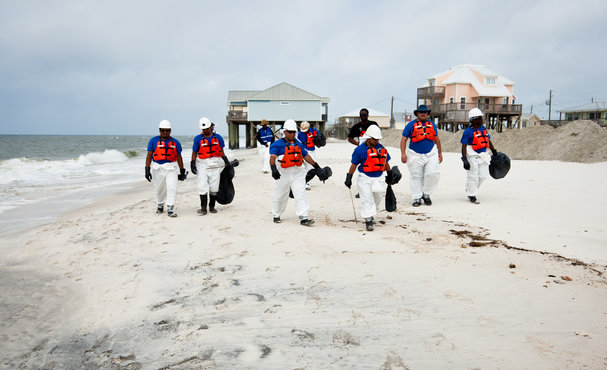
Workers clean up after the 2010 Deepwater Horizon oil spill in the Gulf of Mexico. Credit: MivPiv/Getty
Scientists collaborate more when disaster strikes
Teaming up when things fall apart.
1 August 2019

MivPiv/Getty
Workers clean up after the 2010 Deepwater Horizon oil spill in the Gulf of Mexico.
When hurricane Katrina swept through New Orleans in 2005, it not only left a trail of flooded labs, ruined samples and cancelled field trips in its wake, but also caused a change in how researchers collaborate.
A study found that researchers formed bigger teams, developed new co-author relationships and became more productive following a natural disaster, which could inform how researchers respond to global crises in the future.
Sociologists Thomas Rotolo from Washington State University and Scott Frickel from Brown University analyzed 906 journal articles produced by wetlands scientists based in Louisiana, which in 2005 weathered two hurricanes, Katrina and Rita, and the massive Deepwater Horizon oil spill in 2010.
The papers, published between 1996 and 2015, were grouped into five-year intervals.
The team analyzed changes in the co-author network before and after the disasters, and compared this to collaboration patterns of wetlands researchers based in Washington, which did not experience the disasters.
The results, published in the journal Scientometrics, showed that the Louisiana research network, measured by ties between Louisiana-based co-authors that published papers together, had almost tripled in size since 2005, produced twice as many papers and became significantly more interconnected.
While the number of authors, articles and linked research groups also increased in the Washington network, changes occurred more gradually, and not in response to any particular event.
Strength in numbers
The largest web of researchers in the Louisiana wetlands network grew from 90 scientists prior to the 2005 hurricanes to 287. This accounted for 40% of all wetlands researchers in the 659-strong network based in Louisiana at the time.
This group of linked co-authors expanded further following the Deepwater Horizon oil spill in 2010, growing to more than 400 scientists in five years.
By comparison, the largest group of linked researchers in Washington consisted of 23 scientists, which accounted for 15% of the total network at the time.
The number of single-authored papers published by the Louisiana group dropped by around 14% over the two-decade analysis period, indicating that researchers were teaming up more frequently after the disasters.
In Washington, authors were found to rarely collaborate with those outside of their original network throughout the analysis period, and small, tightknit groups remained the most common feature of wetlands research in the region.
The findings offer a glimpse of how rapid environmental change and the rise of climate-related disasters could affect how scientists work together.
Previous studies have suggested that wider and more diverse scientific collaborations can produce more reliable findings. A 2017 study using Web of Science data revealed that collaborative research is growing. The number of papers with international co-authors has tripled in the past 15 years, rising as a proportion from 10.7% to 21.3% over the period.
Read next:
International collaborations growing fast
